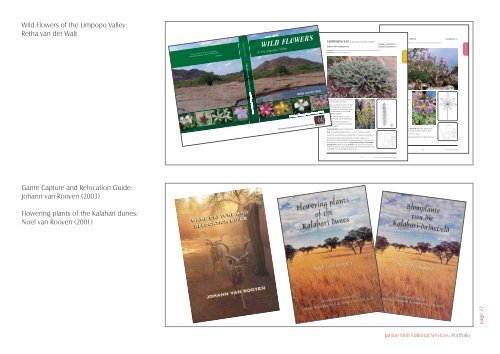View portfolio - jses.co.za
View portfolio - jses.co.za
View portfolio - jses.co.za
Create successful ePaper yourself
Turn your PDF publications into a flip-book with our unique Google optimized e-Paper software.
Wild Flowers of the Limpopo Valley:<br />
Retha van der Walt<br />
Game Capture and Relocation Guide:<br />
Johann van Rooyen (2003)<br />
Flowering plants of the Kalahari dunes:<br />
Noel van Rooyen (2001)<br />
WFotLV_FinalGuide_Cover.indd 1 7/9/2009 1:24:21 PM<br />
Cleome oxyphylla var. robusta<br />
EUPHORBIACEAE (Euphorbia or Rubber Family)<br />
oxyphylla: (Greek) oxys – sharp, and phyllon – a leaf, referring to sharp-pointed leaves;<br />
Limpopo Euphorbia robusta – robust, (E) stout.<br />
Euphorbia limpopoana<br />
Limpopo-euphorbia (A)<br />
Euphorbia – <strong>co</strong>mmemorates Euphorbus, physician to King Juba I of Mauritania (54 B.C.);<br />
limpopoana – from the Limpopo River.<br />
Densely tufted succulent perennial<br />
herb, 300(–450) mm high.<br />
Stems: a <strong>co</strong>mpact clump of often<br />
rebranching stems, produced at<br />
ground level; branches grey-green<br />
with a paler stripe in the middle,<br />
usually four-angled.<br />
Spines: relatively stout; in pairs,<br />
8–17 mm long; spine shield grey.<br />
Flowers: cyathia in groups of<br />
three, above each pair of spines;<br />
yellowish green.<br />
Flowering time: April to September.<br />
Fruit: capsule obtusely lobed, 3 × 4 mm, sessile, purplish.<br />
Found on rocky hills and in sandy soils in mopane woodland.<br />
This species, distributed along the Limpopo Valley from<br />
Botswana to Mo<strong>za</strong>mbique, has been referred to for some time<br />
as a distinct ‘Limpopo form’ of Euphorbia schinzii. Euphorbia<br />
limpopoana differs from E. schinzii in its lack of rhizomatous<br />
branches, and its more robust habit, with thicker branches and<br />
noticeably much stronger spinescence.<br />
133<br />
WFotLV_FinalGuide_Yellow.indd 133 7/9/2009 2:31:17 PM<br />
Yellow and orange<strong>co</strong>loured<br />
flowers<br />
Subwoody herb, up to 1 m<br />
high.<br />
Stems: erect; branching;<br />
<strong>co</strong>vered with glandular hairs.<br />
Leaves: <strong>co</strong>mpound;<br />
petiolate; leaflets (5–)7(–9),<br />
narrowly elliptic; margins<br />
entire, slightly sticky due to<br />
glandular hairs; with a very<br />
strong smell when crushed.<br />
Flowers: inflorescence<br />
a terminal, few-flowered<br />
raceme; individual flowers<br />
larger and petals more<br />
rounded than those of any<br />
of the previously described Cleome species; petals pink,<br />
two upper ones with yellow areas at base, lined in blue.<br />
Fruit: pods, narrow, hairy, ±90 mm long.<br />
Found on rocky hillsides. Well represented in Mapungubwe<br />
National Park.<br />
213<br />
Peultjiesbos (A)<br />
Pink-<strong>co</strong>loured flowers<br />
WFotLV_FinalGuide_Pink.indd 213 7/9/2009 3:12:17 PM<br />
Yellow and orange-<strong>co</strong>loured flowers<br />
Janine Smit Editorial Services: Portfolio<br />
Pink-<strong>co</strong>loured flowers<br />
page 22


